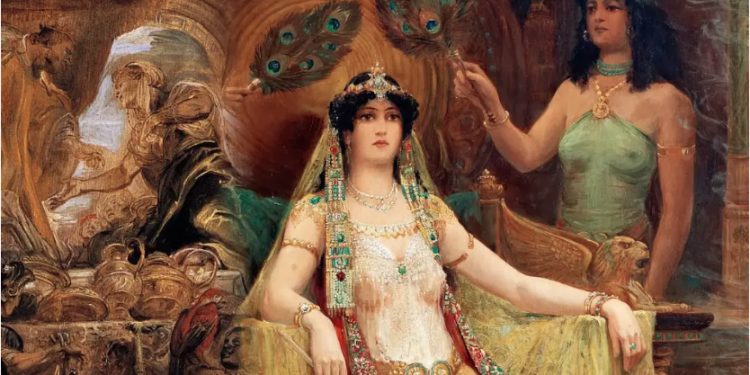HAUNTING LEGENDS OF A MYSTERY QUEEN

Who was the Queen of Sheba?
For well over 30 centuries a beautiful queen from a land named Sheba has both intrigued and fascinated people. The name ‘Queen of Sheba’ first appeared in the 10th chapter of the First Book of Kings in the Old Testament where it is told that she came to Jerusalem upon hearing of the fame of the wise Israelite King Solomon and to probe his wisdom with knotty questions. She arrived there at the head of a caravan of camels laden with spices, gold and gems. The same story is repeated in the 09th chapter of the Second Book of Chronicles. Even in the Gospels of Saints Mathew (12:42) and Luke (11:31) in the New Testament, Jesus speaks of the queen of the south who came from the ends of the earth to hear the wisdom of the king. All these biblical accounts, however, do not mention her name, country, race, appearance or skin colour. Who is this unnamed biblical figure who has so much inspired art, literature and exploration? Was she a queen, a noble woman, a witch or a seductress? Where was the land of Sheba? Did she marry Solomon and bear a son who founded the Solomonic dynasty of Ethiopia that ended with the deposition of Emperor Haile Selassie in 1974? As such innumerable questions surround the personality of this queen, researchers are still wading through history to dig for the truth.
The Bible gives enough evidence of Solomon, the monarch of ancient Israel who was the son of King David. Solomon retained peace in his kingdom by raising a great army of 12,000 horsemen and 1400 war chariots. He consolidated his rule over the tribes of his kingdom by forming alliances with his neighbours and cementing these alliances through intermarriages. He also married the daughter of the Pharaoh of Egypt.
Solomon sought the help of the Phoenicians and traded extensively. He sent 10,000 men a month to work in the mountains of Lebanon, homeland of these Semitic-speaking people. At home he had 70,000 hauliers and 80,000 quarrymen, working on his great temple to the glory of God. Solomon accumulated so much gold that he used it to cover the temple walls. He himself sat on a throne of ivory laid with gold and ate in gold utensils.
Was she an Arabian queen?
Queen of Sheba, on hearing of such wealth and splendour, and also of Solomon’s wisdom, paid a visit to the king to witness everything for herself. She visited Solomon when he was at the zenith of his power. His garrison controlled all roads from the Euphrates (a historically important river originating in Turkey and flowing through Syria and Iraq) to the Sinai Desert, and from the Red Sea to Palmyra, an ancient city in present-day Syria. By the time the queen arrived, Solomon had completed the great temple and the royal city of Jerusalem.
Although the Bible has little to say about her, the tradition and folklore have much information to impart. Some ancient writings refer to the Arabian Kingdom bordering the Red Sea as the place where she ruled. In fact, the birth of her name can be traced to Genesis where it was not a place but a person, a descendant of Noah’s son, Shem, the father of the Semites who include Arabs, Jews, Canaanites, Akkadians, some Ethiopians and Aramaean tribes who spoke Aramaic, the language of Jesus. Sheba had 12 brothers and the names of the brothers were adopted by people and places in Arabia. Till 6th century A. D., Hazarmoth, Sheba, Ma’in and Qataban were combined together. Out of these four, the place Sheba was the biggest. Frankincense and myrrh trees were grown on the mountainous slopes of the country which formed its basic trade. The first century Greek historian Diodorus Siculus of Sicily described the riches of its capital city. The natives of Sheba (or Saba) that included Arabia Felix, the Latin name previously used by geographers to describe the South Arabian Peninsula in modern-day Yemen, worshipped the celestial bodies: Sun, Moon and Venus. Their system of government by priest kings was similar to the Sumerians and their writings and alphabet were identical to those of the Phoenicians. Although Sheba was protected from all sides by desert, in 25-24 B. C., a Roman army under Gaius Aelius Gallus, a Roman prefect of Egypt, invaded the kingdom under orders of Augustus Caesar, but many soldiers died from heat and thirst.
The Queen of Sheba appears in the Quran as Bilqis whose story has been embellished by Muslim commentators. The Arabs have given her a southern Arabian genealogy and the Temple of the Moon in Yemen is often called the ‘Haram Bilqis’, meaning the palace of Bilqis. She has become the subject of widespread legends. One such story narrates that Solomon, having heard from one of his birds that Bilqis and her kingdom worshipped the Sun, asked her to worship instead the Lord God of Israel. When she came to his court the king’s jinn (supernatural beings in early pre-Islamic folklore and later in Arabian tradition as well), fearing that the king might be tempted into marrying Bilqis, whispered to him that she had hairy legs and hooves of an ass. Being curious about it, the wise king had a glass floor built before his throne. Bilqis thought that it was water, raised her skirts to cross it and revealed her truly hairy legs. Solomon then ordered the jinn to use a depilatory to remove her hair. Islamic tradition does not agree as to whether Solomon married Bilqis, but she did, however, become a believer of God.
In February 1934, Georges André Malraux (1901-1976), French novelist and a former Minister of Cultural Affairs in France, embarked on a much publicised expedition to find the lost city of the Queen of Sheba, mentioned in the Old Testament. After several weeks of flying over the deserts in Saudi Arabia and Yemen, Malraux returned to his country and announced that the ruins he saw up in the mountains of Yemen were the lost city of the queen. Malraux’s claim is not generally accepted by archaeologists but his expedition bolstered his fame and provided the material for his later novels.
An African queen from Ethiopia?
Kebra Nagast (The Glory of Kings), the 14th century national epic from Ethiopia, also formerly known as Abyssinia, is at least 700 years old and is considered by many Ethiopian Orthodox Christians to be a historically reliable work that holds the genealogy of the Solomonic dynasty. The Queen of Sheba appears as a prominent figure in this text where she is named the beautiful Queen Makeda of the land of Sheba, identified as ancient Ethiopia. Kebra Nagast says that Queen Makeda visited Solomon’s court on hearing about his wisdom. She stayed and learned from him for six months and on the last night of her visit, she was tricked into his bed when Solomon impregnated her. Makeda then returned to her kingdom in Ethiopia and on the way bore him a son named Menelik. When the boy turned 22, he travelled to Jerusalem to meet his father. King Solomon was delighted to see his son and tried in vain to convince Menelik to remain in Israel and succeed him as king. As Menelik opted for returning to the land of his mother, Solomon sent him back to Ethiopia and the Ark of the Covenant also travelled with the retinue. To this day, many Ethiopians believe that it is housed in the Chapel of the Tablet next to the Ethiopian Orthodox Church of Our Lady, Mary of Zion in the town of Axum. Menelik I was enthroned by Solomon, his father, thus founding the royal Solomonic dynasty of Ethiopia, which ruled the country until the deposition of Haile Selassie I (1892-1975), emperor of Ethiopia, in 1974.
Bar Kribus is an Israeli archaeologist who holds a doctorate from the Hebrew University of Jerusalem, affiliated to the Ruhr University in Bochum, Germany, and now based in Tel Aviv in Israel. He specialises in Ethiopian archaeology, especially the religious life of the Ethiopian Jews. According to him, the kings of Ethiopia were seen as direct descendants of the House of David, rulers by divine light. Basing himself on the evidence at hand, Dr. Kribus, in exclusive comments for Namo, said that the queen of Sheba is mentioned in the Bible, and this theme is further developed in later texts and traditions, such as Kebra Nagast. “In antiquity, there was indeed a kingdom of Saba, in South Arabia, which is well-known through archaeological and epigraphical finds, and mentioned in various texts. This is probably the kingdom that the author of the biblical account had in mind when writing about the queen”, he said. The scholar further confirmed that since antiquity, there have been very close cultural ties between Ethiopia and South Arabia, and many South Arabian (including Sabaean) cultural elements are expressed in the archaeological record in Ethiopia, such as script, deities worshipped, art, etc. Dr. Kribus affirmed that the heritage of biblical Sheba is one of the cornerstones of Ethiopian culture, and a central part of the Kebra Nagast narrative. “So, in terms of heritage and cultural impact and importance, Ethiopia is by far the place which is most affiliated with the Queen of Sheba”, he told Namo.
Based on the Gospels of Matthew and Luke, the “queen of the south” is claimed to be the queen of Ethiopia. In those times, King Solomon sought merchants from all over the world to buy materials to build his Temple. A renowned merchant of the Queen Makeda, by the name of Tamrin, was among them. On returning to Ethiopia, he told the queen of the grandeur he had witnessed in Jerusalem, and also of Solomon’s wisdom and generosity, which prompted the queen to see the king. She was accorded a warm welcome and given a place to dwell and received valuable gifts every day.
In the late 1st century, Flavius Josephus (37 A. D.-100 A. D.), Roman-Jewish historian and military leader, wrote a history of the Jews where he retold the stories of the Bible and said that the Queen of Sheba ruled over Ethiopia and Egypt. In the first half of the 3rd century, Origen of Alexandria, a Christian theologian and ascetic, claimed that the Queen of Sheba was “black and beautiful”.
A symbol of lust?
The traditions about her visit appear first in the Bible and later in the Quran and in a number of other writings such as the Talmud (the book of Jewish Theology), Midrash (textual interpretation of the Talmud) and Ethiopian literature. Herodotus (484 B. C.-425 A. D.), Greek historian and geographer and Father of History; Strabo (64 B. C.-24 A. D.), Greek geographer, historian and philosopher; and Pliny the Elder (23 A. D.-79 A. D.), Roman author and naturalist all mention the name Sheba.
The view about this queen has hardly undergone a change in the 20th century. She still remains seductive. Irish poet, dramatist and politician William Butler Yeats (1865-1939) often portrayed her sexual and secular nature. The religious art of the Christian Middle Ages and Renaissance, covering the 15th and 16th centuries in the history of Europe, often depicts her. The sculptures of the Gothic Cathedrals of England, France, Germany and Italy often show her as a queen and at times as a sorceress. Some of the Jewish traditions also identify the queen with Lilith, a demonic seductress and the first wife of Adam.
In the 19th century, she played another role. In La Tentation de Saint Antoine (The Temptation of Saint Anthony), a dramatic poem in prose (1874) by French novelist Gustave Flaubert (1821-1880), the queen is made to represent Lust. She attempts to woo St. Anthony in the desert near Thebes. First she tempts him with her wealth and when she fails in her attempts she seduces the saint showing her body. When St. Anthony is not tempted by her physical charms either, the seductress reveals a deformed foot and goes away.
Her name is mentioned in the stories of the English novelist Joseph Rudyard Kipling (1865-1936) and in Three Soldiers by the American novelist John Dos Passos (1896-1970). The story of this queen equally appears among the Persians (probably derived from Jewish traditions), where she is regarded as the daughter of a Chinese king and a peri (a winged fairy like spirit in Persian mythology).
Among those who have produced exquisite paintings of the queen are Italian painters Piero della Francesca and Giovanni De Min and French painter Claude Lorrain. Although some paintings and images of today of the queen show Semitic racial features of the Arabs, a majority of them portrays a black-skinned lady with negroid features.
The Queen of Sheba was revered as a model of wisdom, beauty and faith in Judaism, Islam and Christianity. She was a seeker of knowledge and a powerful ruler of a wealthy kingdom in either Arabia or Ethiopia, as the location of her kingdom, let alone her real name, is still being debated. She was also a brave, courageous and self-assured woman who ventured to meet one of the mightiest kings of her time. ***







